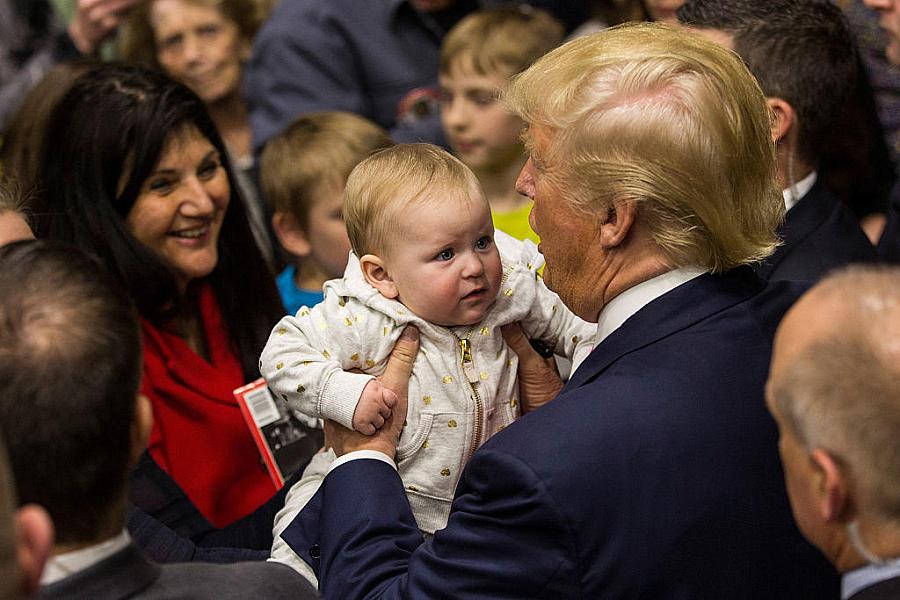Election result could have major implications for children’s coverage

Photo: Andrew Burton/Getty Images
Much of the health policy discussion in the wake of Donald Trump’s victory this week has focused on the big burning question: What happens to Obamacare now? While the sudden sea change in the fight over the law’s future will generate a steady stream of headlines over the months to come, it’s worth pausing for a moment to ask what the GOP’s pledge of “repeal and replace” might mean for children.
The question of children’s health coverage will gain new urgency next year since funding for the Children’s Health Insurance Program expires on Sept. 30, 2017. The program, which covers kids in lower-income families whose incomes are too high for Medicaid, had a star turn during the campaign this year due to Hillary Clinton’s contested role in securing the bill’s 1997 passage.
The CHIP program, in conjunction with Medicaid, has been widely credited with helping drive down the uninsured rate among children — from 14 percent in 1997 to less than 5 percent in 2015, a year in which 8.4 million children were enrolled in a CHIP program. That’s an increase of nearly 300,000 kids from the previous year.
Yet it wasn’t expected to play out this way. Architects of the Affordable Care Act originally expected CHIP enrollees to transition to plans on the health exchanges. CHIP then would eventually become irrelevant, since lower-income families would qualify for federal subsidies to buy coverage on the health marketplace. It hasn’t worked out that way. As studies and children’s health advocates have repeatedly pointed out, CHIP often provides more generous benefits and imposes lower out-of-pocket costs compared with, say, a typical “silver” exchange plan. High deductibles and co-pays can result in skipped care for privately insured kids, especially in less affluent families.
The CHIP program’s funding was set to expire in September 2015 but was given a bit a two-year reprieve in April of that year, when an unusually bipartisan Congress approved a two-year funding extension as part of the so-called doc fix bill. But time is once again running out.
“In practice, if Congress wants to extend CHIP, it needs to act early in 2017 because many states have fiscal years that begin in July and need lead time to plan their budgets,” wrote KHN’s Julie Rovner after the election this week.
For his part, Trump has spoken positively of CHIP and has credited its role in expanding coverage to kids. But in response to questions from the American Academy of Pediatrics, he also said the program “should be streamlined with funds being block-granted to the states.” He argues such a move gives states more flexibility to design programs that cut costs and recruit more doctors with higher reimbursement rates.
Such a possibility has drawn immediate concern from some of CHIP’s biggest advocates this week. Joan Alker, executive director of the Center for Children and Families at Georgetown University, wrote:
There are many different ways the Republican majority could go on CHIP, and it’s very hard to say which direction they will take. But if history is any guide, we can expect that they will push for less federal money going in to the program and more state flexibility which translates to fewer protections for children.
The calculus grows in complexity when Obamacare is factored in. If Trump and Congress were to repeal the ACA and eliminate the federal subsidies that enable lower-income families to buy exchange plans, that could make CHIP even more of a life-ring for families whose modest incomes are too high for Medicaid.
Yet if CHIP were to suffer funding cuts or worse as it comes up for reauthorization next year, that could result in a double loss of affordable insurance options for kids in low-income families. Alternatively, if CHIP was funded through block grants, how might states change their programs’ benefits and eligibility requirements? Those are all open questions.
CHIP’s defenders have reason to worry. Last year, Republicans in Congress proposed a draft of changes that could have curbed federal funds and restricted eligibility while allowing states to adopt a 12-month waiting period before kids can enroll in CHIP after losing coverage from a parent’s plan.
And then there’s the much larger question of how the GOP might seek to change Medicaid. Children make up just over half of Medicaid’s 73 million enrollees, and so any changes there could have major reverberations for kids. Trump has proposed moving Medicaid to a system of block grants as well. Republicans have backed the block grant idea for more than two decades, while opponents counter that “block grants’ basic structure makes them especially vulnerable to funding reductions over time.” Alternatively, some Congressional Republicans favor per capita caps for Medicaid.
As Kaiser Health News’ Phil Galewitz reported Wednesday in a story headlined “Million could lose Medicaid coverage under Trump plan,” critics say such block grants “could give states flexibility to make cuts in federally required benefits, such as health screenings for infants and children.”
That in turn would raise concerns among children’s advocates about the possibility of a vast patchwork of children’s health benefits, with potentially wide disparities between states.
Regardless of one’s political leanings here, it’s going to be one bumpy ride.
